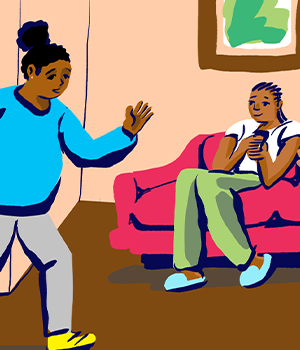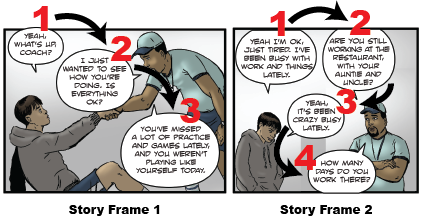Menu
Family and Dependency Court
Criminal Court
Human Trafficking
Children and Youth in Tribal Communities
A Guide for Parents and Caregivers
These materials were designed for youth aged 12−18 who have experienced sex and labor trafficking, to help inform and empower them as they navigate through the justice system.
They were created with the input of those with similar lived experiences, and expert practitioners working in the anti-trafficking field.
While the materials are intended to be relatable to the broadest possible audience, it’s important to acknowledge that every person has their own unique experience with trafficking and the justice system, so not every element of the materials will feel relevant to every young person, caregiver, or community.
As a caregiver, we encourage you to discuss the similarities and differences between your child’s experience and the story presented in the materials, whether that be in the case details, the people involved, or in the local cultural and community setting.
Translations
Translations of the Guide for Parents and Caregivers are available in—
View the English guide below.
How to Read the Materials
The materials include three short graphic novels (Sergio’s Story and Zoe’s Story), plus an accompanying booklet, titled What’s Going On?, that focuses on rights, roles, and responsibilities within the justice system.
Graphic novels are broken up into separate story frames or panels. A story frame is an individual drawing on a single section of the page, and each frame is separated by boxes. These frames are read in order from left-to-right like a traditional storybook and then top-to-bottom.
The speech bubbles within each frame are most often read from left-to-right and then top-to-bottom, when applicable. See the graphic below for an example of two story frames from Sergio’s Story.
Some of the novels use different color schemes and time markers to indicate flashback scenes, where the story transitions from the present day to an event that occurred in the past.
How to Use the Materials
It is so important that your child feels supported during this stressful time. Going through these materials together is one way that you and your child can connect and talk about what’s been happening, and learn more about the justice system processes together.
If anything in the materials is unclear, ask an advocate (or the person who provided you with the materials) to explain, so that you are comfortable going through the materials with your child.
- We recommend that you read through the materials first, before going through them with your child.
- If your child has difficulty reading, either you or someone working on their case, such as a therapist or advocate, can read the materials with them.
- Regardless of your child’s age, you play a very important role by helping them understand what they are reading and providing emotional support.
- The materials can be read at one time, or different sections can be used at different times, depending on your child’s age, your family’s situation, and how your child is feeling. It can also be helpful to refer to the What’s Going On? booklet for further information and explanations of different terms that are mentioned throughout the stories.
- As you read the stories, you’ll come across activities along the way. Encourage your child to try the activities because they teach coping skills that can help your child (and maybe you!) de-stress. You can also use the activities as reminders to take a break and check in with your child about the emotions they may be feeling.
- Be mindful that young people can be triggered by anything that reminds them of the traumas they have experienced. If your child becomes distressed at any time, it is okay (and helpful) to take a break, offer support, and practice coping skills like deep breathing together.
- Feel free to make changes to the stories so that they work well for your child. This might mean changing the details of what happened or using words that make more sense in your family and community.
- Ask your child questions to help connect the story to their feelings and experiences. For example: Zoe was frustrated when this happened—how do you think you would have felt if you were in the same situation?
Tips for Supporting Your Child
Here are some ways to support your child while using these materials, and as they go through this experience:
- Let them know that it’s okay to have strong feelings, or no feelings at all, and there are things they can do to feel better.
- Remind them that none of this is their fault.
- Be patient with your child as they may not feel ready to discuss all details with you.
- Tell them that they are not the only one that has gone through this; other young people and families have had these experiences, too.
- Remind them that there are people who support them, such as family members, friends, caseworkers, advocates, therapists, and lawyers, and name those people together.
- Encourage your child to ask as many questions as they’d like, and to express their thoughts and feelings to you and to the people working on their case.
- Try to find times to laugh together, engage in a fun hobby, and do physical things like taking a walk. These are important for taking care of yourself and each other.
- Limit your child’s exposure to conversations, TV shows, movies, and other media, that talk about violence or other upsetting topics.
- Consider allowing your child to make choices whenever possible, even about little things such as what food to eat, which errand to do first, or which parts of these materials to work on together. This helps young people feel a sense of personal power and control again.
- Encourage your child to stick to their usual daily routines as much as possible; knowing what to expect helps young people feel safer and more secure.
- Remind your child that they are strong and will get through this.
One more note: Because you are so important to your child, one of the best things you can do for them is to take care of yourself! That way you can support them as best you can. So, don’t forget to do things to help yourself feel better and heal, and ask any questions that you have, too.
You can also talk with your advocate or social worker about services and supports that might be helpful to your own healing and well-being.



